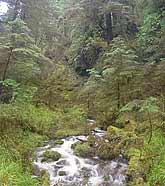Managing the non-karst portion of karst catchment areas (lesson 9)
On this page
Learning objectives
This lesson discusses management strategies for the non-karst portion of karst catchments. By working through this lesson you will be able to:
- Recognize the management objectives for the non-karst portion of karst catchments
- Identify best management practices for the non-karst portion of karst catchments based on the vulnerability of the karst
Introduction
As you work through this lesson, you will understand the management strategies for the non-karst portion of karst catchments based on the vulnerability of the downstream karst unit.
What are karst catchment areas?
Karst catchment areas are comprised of all lands contributing surface runoff and/or diffuse recharge to the karst system, including upstream non-karst areas.
When and how are karst catchment areas identified?
Karst catchments are delineated during karst inventories. Dye tracing can be used to determine subsurface flow paths, particularly in cases where subsurface hydrological connections cross surface drainage divides.
What is the main management objective for the non-karst portion of a karst catchment?
To maintain the water quality and quantity of streams that sink or lose water into downstream karst units.
NOTE: Where downstream karst resources are significant and vulnerable to inputs of sediment and debris from sinking or losing streams, temperature fluctuations, or changes in flow characteristics, some modification to default standards for riparian management as specified in the regulations supporting the Forest and Range Practices Act may be necessary.
Surface streams flowing off non-karst portions of karst catchments that do not sink or lose water to downstream karst units can be managed following the riparian management default standards as specified in the regulations supporting the Forest and Range Practices Act.
Recommended best management practices
The following section summarizes the recommended best management practices for the non-karst portion of karst catchment areas. Be sure to check out more detailed information in the Karst Management Handbook for British Columbia.
Non-karst catchments contributing to low vulnerability areas
Use default standards for riparian management as specified in the regulations supporting the Forest and Range Practices Act.
Non-karst catchments contributing to moderate and high vulnerability areas
Follow the recommendations for managing sinking and losing streams outlined in the Riparian Management for Sinking and Losing Streams/Sinking Watercourses section of the Karst Management Handbook for British Columbia.
Non-karst catchments contributing to very high vulnerability areas
- Very high vulnerability karst terrain likely contains provincially or even nationally or internationally significant karst resources. Features with direct hydrological inputs from non-karst portions of catchment areas will likely be highly sensitive to fluctuations in water quality, water quantity, nutrient content, and water chemistry
When managing these areas:
- Consider the potential for increased runoff, higher stream velocities, and increased sediment and debris transport when developing management strategies for non-karst catchment areas draining into very high vulnerability areas
- Consider partial-cutting systems, smaller dispersed cutblocks, maximum suspension yarding, and extended rotation periods to reduce the impacts of increased runoff resulting from harvesting
- In some cases, a watershed assessment may be necessary for determining an appropriate equivalent clearcut area (ECA) for the non-karst catchment area
- Sinking and losing streams should be managed as outlined in the Riparian Management for Sinking and Losing Streams/Sinking Watercourses section of the Karst Management Handbook for British Columbia
Self check questions
Answer either True or False to check your understanding.
- Dye tracing can be useful for determining the flow paths of subsurface streams.
- The main management objective for the non-karst portion of a karst catchment is to maintain the water quality and quantity of streams that sink or lose water into downstream karst units.
- When managing non-karst catchment areas contributing water to very high vulnerability areas, practices such as partial cutting or smaller cutblocks may need to be considered to reduce the risk of increased runoff after harvesting.
Self check answers
- True
- True
- True

